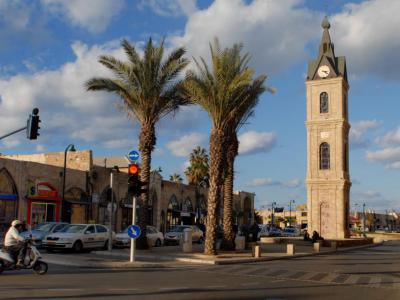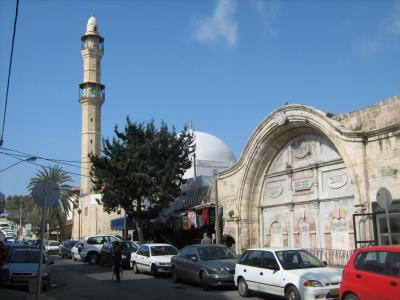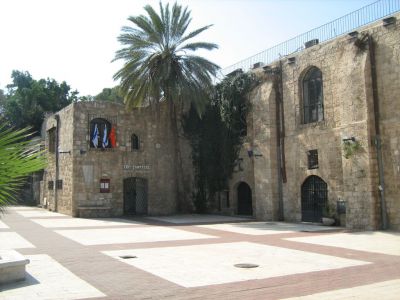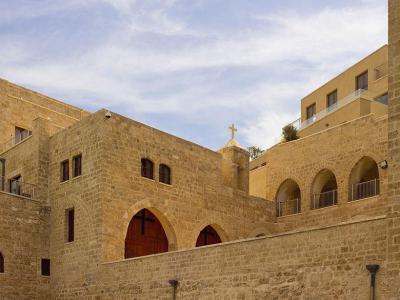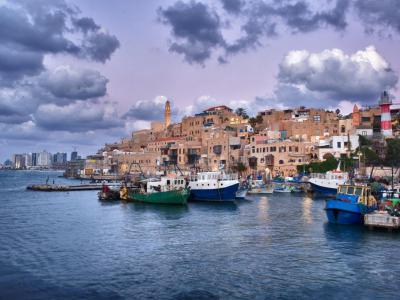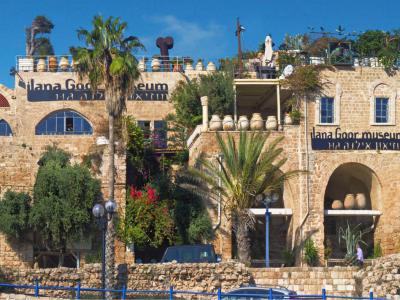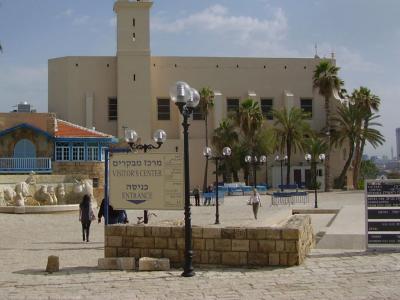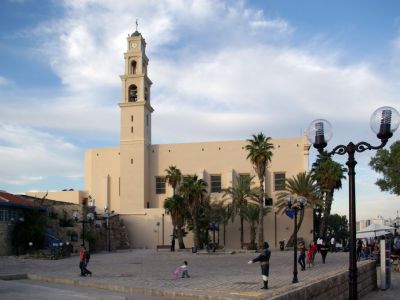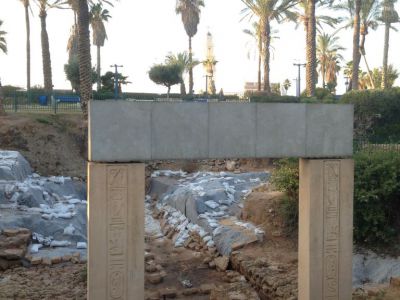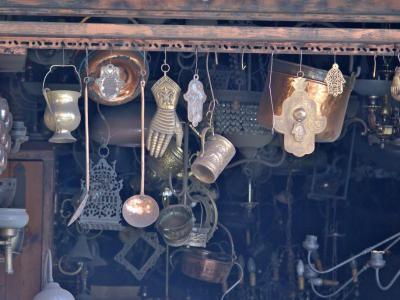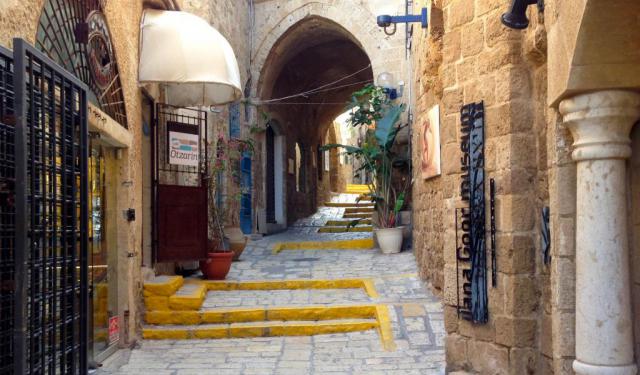
A Walk in The Old City of Jaffa (Self Guided), Tel Aviv
One of the oldest port cities on the Mediterranean coast, the first record of which dates back to the 15th century BC, Jaffa is a part of Tel Aviv, although quite different in terms of vibe. Famous for its ancient slate houses and narrow winding stone roads, it feels a bit similar to the ancient towns of Asia, but far less noisy and not too crowded.
Also, devoid of the strong religious atmosphere, Jaffa appears quite relaxed. So, let's take a quick look at this enchanting area and see what it's famous for.
The iconic Jaffa Clock Tower, a timeless symbol of the city, stands tall and proud. Not far from it, around the corner, the Great Mahmoudiya Mosque showcases stunning architecture and a rich religious history. For those seeking to delve into the past, the nearby Old Jaffa Museum of Antiquities offers a glimpse into the region's ancient heritage.
Further ahead, Saint Nicholas Monastery, an oasis of tranquility, welcomes visitors with its serene ambiance. Strolling along the cobbled streets, you'll come across the picturesque Old Jaffa Port, where history whispers through the ancient stones.
Art lovers can explore the Ilana Goor Museum, home to a diverse collection of contemporary art. Meanwhile, Kedumim Square, adorned with the Fountain of Zodiac Signs, is a hub of activity and cultural events.
The majestic Saint Peter's Church in the vicinity catches the eye with its distinctive white-stone architecture. On the other hand, Summit Garden (HaPisga) and Ramses II's Gate Garden offer picturesque vistas of the city and its surroundings.
One can't miss the Suspended Orange Tree either, a unique piece of art suspended in mid-air, representing the resilience of life. At the same time, the vibrant Jaffa Flea Market is a treasure trove of eclectic finds, while Abouelafia Bakery tantalizes taste buds with delicious pastries and treats.
In the Old City of Jaffa, history, culture, and art converge, creating a rich tapestry of attractions inviting exploration and discovery. So, whenever you're in Tel Aviv, make sure to include Jaffa in your travel plans. A history buff within you, an art aficionado, or someone looking for a charming and authentic experience will thank you for that.
Also, devoid of the strong religious atmosphere, Jaffa appears quite relaxed. So, let's take a quick look at this enchanting area and see what it's famous for.
The iconic Jaffa Clock Tower, a timeless symbol of the city, stands tall and proud. Not far from it, around the corner, the Great Mahmoudiya Mosque showcases stunning architecture and a rich religious history. For those seeking to delve into the past, the nearby Old Jaffa Museum of Antiquities offers a glimpse into the region's ancient heritage.
Further ahead, Saint Nicholas Monastery, an oasis of tranquility, welcomes visitors with its serene ambiance. Strolling along the cobbled streets, you'll come across the picturesque Old Jaffa Port, where history whispers through the ancient stones.
Art lovers can explore the Ilana Goor Museum, home to a diverse collection of contemporary art. Meanwhile, Kedumim Square, adorned with the Fountain of Zodiac Signs, is a hub of activity and cultural events.
The majestic Saint Peter's Church in the vicinity catches the eye with its distinctive white-stone architecture. On the other hand, Summit Garden (HaPisga) and Ramses II's Gate Garden offer picturesque vistas of the city and its surroundings.
One can't miss the Suspended Orange Tree either, a unique piece of art suspended in mid-air, representing the resilience of life. At the same time, the vibrant Jaffa Flea Market is a treasure trove of eclectic finds, while Abouelafia Bakery tantalizes taste buds with delicious pastries and treats.
In the Old City of Jaffa, history, culture, and art converge, creating a rich tapestry of attractions inviting exploration and discovery. So, whenever you're in Tel Aviv, make sure to include Jaffa in your travel plans. A history buff within you, an art aficionado, or someone looking for a charming and authentic experience will thank you for that.
How it works: Download the app "GPSmyCity: Walks in 1K+ Cities" from Apple App Store or Google Play Store to your mobile phone or tablet. The app turns your mobile device into a personal tour guide and its built-in GPS navigation functions guide you from one tour stop to next. The app works offline, so no data plan is needed when traveling abroad.
A Walk in The Old City of Jaffa Map
Guide Name: A Walk in The Old City of Jaffa
Guide Location: Israel » Tel Aviv (See other walking tours in Tel Aviv)
Guide Type: Self-guided Walking Tour (Sightseeing)
# of Attractions: 13
Tour Duration: 2 Hour(s)
Travel Distance: 2.1 Km or 1.3 Miles
Author: max
Sight(s) Featured in This Guide:
Guide Location: Israel » Tel Aviv (See other walking tours in Tel Aviv)
Guide Type: Self-guided Walking Tour (Sightseeing)
# of Attractions: 13
Tour Duration: 2 Hour(s)
Travel Distance: 2.1 Km or 1.3 Miles
Author: max
Sight(s) Featured in This Guide:
- Jaffa Clock Tower
- Great Mahmoudiya Mosque
- Old Jaffa Museum of Antiquities
- Saint Nicholas Monastery
- Old Jaffa Port
- Ilana Goor Museum
- Kedumim Square / Fountain of Zodiac Signs
- Saint Peter's Church
- Summit Garden (HaPisga)
- Ramses II's Gate Garden
- Suspended Orange Tree
- Jaffa Flea Market
- Abouelafia Bakery
1) Jaffa Clock Tower (must see)
One of the most fascinating tourist attractions in Tel Aviv, this clock tower anchors a busy square that practically any visitor to Jaffa will walk through. Since 1903, it marks the central point of Jaffa, surrounded by historical buildings, a beautiful beach, the flea market and many cool shops, galleries, restaurants and more – a great area to explore.
While not itself a most impressive monument, the clock tower is very prominent, having kickstarted the construction of more than a hundred similar structures throughout the Ottoman Empire. It has a total of four clocks, two of which show time in Israel and the other two in Europe. In the year 2001, as part of the renovation plan of the entire square, the tower was also renovated, and a small Russian-style turret now adorns its top.
Why You Should Visit:
It stands in a vibrant, busy area. It is ancient and authentic. It tells you the time.
Not very impressive compared to Big Ben, but not bad compared to other towers.
While not itself a most impressive monument, the clock tower is very prominent, having kickstarted the construction of more than a hundred similar structures throughout the Ottoman Empire. It has a total of four clocks, two of which show time in Israel and the other two in Europe. In the year 2001, as part of the renovation plan of the entire square, the tower was also renovated, and a small Russian-style turret now adorns its top.
Why You Should Visit:
It stands in a vibrant, busy area. It is ancient and authentic. It tells you the time.
Not very impressive compared to Big Ben, but not bad compared to other towers.
2) Great Mahmoudiya Mosque
The third most important mosque in Israel after Jerusalem's Al-Aqsa and Hebron's Cave of the Patriarchs, Mahmoudiya was first built in 1730, with surrounding buildings, gates, and courtyards having been added in stages through the 18th and 19th centuries while Southern Syria was under Ottoman rule.
The courtyard welcomes you with its tranquil views of palm trees and colorful flowers, but the gates to the mosque proper are usually closed to visits unless they are pre-arranged. Interior decorations are intricate yet not too complex, with names of major prophets written on the corners of the two domes: Muhammad, Jesus, Moses, Abraham, Noah, and others.
While the mosque's exterior walls are largely concealed by shops, the tall and refined silhouette of the minaret is still prominent in what remains of the fabric of Old Jaffa and its surroundings.
Tip:
Don't miss the washing/purification/fountain area attached to the front the mosque facing the street. Free water was once a ruler's gracious gift to his people; nowadays, it's just nice to look at.
The courtyard welcomes you with its tranquil views of palm trees and colorful flowers, but the gates to the mosque proper are usually closed to visits unless they are pre-arranged. Interior decorations are intricate yet not too complex, with names of major prophets written on the corners of the two domes: Muhammad, Jesus, Moses, Abraham, Noah, and others.
While the mosque's exterior walls are largely concealed by shops, the tall and refined silhouette of the minaret is still prominent in what remains of the fabric of Old Jaffa and its surroundings.
Tip:
Don't miss the washing/purification/fountain area attached to the front the mosque facing the street. Free water was once a ruler's gracious gift to his people; nowadays, it's just nice to look at.
3) Old Jaffa Museum of Antiquities
Hovering atop a hill in the Old Jaffa quarter near the sea, this museum is located within an Ottoman-era building erected on the ruins of an 11th-century Crusader fortress. Inside are displays of ancient archaeological items alongside traveling/rotating contemporary art exhibitions.
The permanent artifacts showcase the rich and varied history of the many civilizations that conquered Jaffa throughout its long history, starting with the Stone Age and moving onwards to the Canaanites, Egyptians, Persians, Philistines, Phoenicians, Greeks, Hasmoneans, Romans, Byzantines, Ottomans and the British. Each culture has left its mark on Jaffa and the museum devotes special attention to some of the artifacts and archaeological objects that they left behind.
Among the highlights are an 8th-century BC transcription of Sennacherib, King of Assyria (reigned 705-681 BCE), as well as personal items belonging to a Jewish family who lived in the area during the Roman Empire some 2,000 years ago.
Tip:
Due to hosting private events, the museum may be occasionally closed to the public.
The permanent artifacts showcase the rich and varied history of the many civilizations that conquered Jaffa throughout its long history, starting with the Stone Age and moving onwards to the Canaanites, Egyptians, Persians, Philistines, Phoenicians, Greeks, Hasmoneans, Romans, Byzantines, Ottomans and the British. Each culture has left its mark on Jaffa and the museum devotes special attention to some of the artifacts and archaeological objects that they left behind.
Among the highlights are an 8th-century BC transcription of Sennacherib, King of Assyria (reigned 705-681 BCE), as well as personal items belonging to a Jewish family who lived in the area during the Roman Empire some 2,000 years ago.
Tip:
Due to hosting private events, the museum may be occasionally closed to the public.
4) Saint Nicholas Monastery
Located in the old city of Jaffa, near the harbor of the ancient Mediterranean port city, this Armenian monastery dating to the first millennium AD consists of a large multi-story complex that includes a church and living quarters.
Named for Saint Nicholas, the patron saint of sailors, the monastery gave shelter to pilgrims and seamen looking for a rest on their journey for many centuries. In the 1700s, it was expanded and fortified, and despite not being functional anymore, remains under the jurisdiction of the Armenian Patriarchate of Jerusalem who rents out parts of the complex.
During the Napoleonic Campaign in Egypt at the turn of the 19th century, the French army requested the aid of the Armenian priests at the monastery. After the clerics used their secret medicines to cure some of the soldiers, Napoleon personally thanked the Armenian patriarch and gifted him with his own tent and sword. His visit to the site was depicted in the "Bonaparte Visiting the Plague Victims of Jaffa" painting by Antoine-Jean Gros.
Named for Saint Nicholas, the patron saint of sailors, the monastery gave shelter to pilgrims and seamen looking for a rest on their journey for many centuries. In the 1700s, it was expanded and fortified, and despite not being functional anymore, remains under the jurisdiction of the Armenian Patriarchate of Jerusalem who rents out parts of the complex.
During the Napoleonic Campaign in Egypt at the turn of the 19th century, the French army requested the aid of the Armenian priests at the monastery. After the clerics used their secret medicines to cure some of the soldiers, Napoleon personally thanked the Armenian patriarch and gifted him with his own tent and sword. His visit to the site was depicted in the "Bonaparte Visiting the Plague Victims of Jaffa" painting by Antoine-Jean Gros.
5) Old Jaffa Port (must see)
Old Jaffa Port in Tel Aviv, is a site of immense historical and cultural significance, with a rich history that dates back over 7,000 years. As one of the oldest known ports in the world, it has been a pivotal location in the Eastern Mediterranean, playing a crucial role in various historical events and narratives.
The port is deeply intertwined with the origins of the city of Tel Aviv itself. Throughout history, it has been mentioned in several ancient works, including the Hebrew Bible. Notably, it is cited as the departure point for Jonah, a figure in Jewish history. The port also features in accounts of the First Jewish Revolt against Rome, underscoring its significance in Jewish heritage.
Jaffa Port's strategic importance is highlighted by its usage by a diverse range of cultures and empires. It has seen the presence of Egyptians, Ethiopians (with legends such as Andromeda being chained to a rock here), Philistines, and the Jewish nation, including notable figures like King Solomon and Jonah. Additionally, it has been under the control of various empires such as Babylon, Alexander the Great, and in more recent history, the Ottoman, French, and British empires, before becoming part of Modern Israel.
Despite being smaller than the ports of Haifa and Akko, Jaffa Port retains its iconic status and continues to be a major cultural attraction. Its enduring appeal draws tourists globally, offering a blend of historical insight and modern amenities. The port remains operational, serving local fishermen and salesmen, and also houses modern facilities like art and photography exhibitions. The surrounding cultural centers provide visitors with a deeper understanding of this fascinating location.
The area around Jaffa Port is also known for its culinary and shopping experiences. It boasts several renowned restaurants, beautifully decorated warehouses, and a selection of shops. The port's promenade is particularly appealing, offering a refreshing sea breeze that is especially enchanting at sunset. During this time, the area is bathed in a beautiful orange glow, creating a picturesque scene cherished by both locals and tourists.
Tip:
Use the promenades – extending both north and south – for nice walks and for views over the old town walls and shoreline (the better views are probably from the top looking down).
The port is deeply intertwined with the origins of the city of Tel Aviv itself. Throughout history, it has been mentioned in several ancient works, including the Hebrew Bible. Notably, it is cited as the departure point for Jonah, a figure in Jewish history. The port also features in accounts of the First Jewish Revolt against Rome, underscoring its significance in Jewish heritage.
Jaffa Port's strategic importance is highlighted by its usage by a diverse range of cultures and empires. It has seen the presence of Egyptians, Ethiopians (with legends such as Andromeda being chained to a rock here), Philistines, and the Jewish nation, including notable figures like King Solomon and Jonah. Additionally, it has been under the control of various empires such as Babylon, Alexander the Great, and in more recent history, the Ottoman, French, and British empires, before becoming part of Modern Israel.
Despite being smaller than the ports of Haifa and Akko, Jaffa Port retains its iconic status and continues to be a major cultural attraction. Its enduring appeal draws tourists globally, offering a blend of historical insight and modern amenities. The port remains operational, serving local fishermen and salesmen, and also houses modern facilities like art and photography exhibitions. The surrounding cultural centers provide visitors with a deeper understanding of this fascinating location.
The area around Jaffa Port is also known for its culinary and shopping experiences. It boasts several renowned restaurants, beautifully decorated warehouses, and a selection of shops. The port's promenade is particularly appealing, offering a refreshing sea breeze that is especially enchanting at sunset. During this time, the area is bathed in a beautiful orange glow, creating a picturesque scene cherished by both locals and tourists.
Tip:
Use the promenades – extending both north and south – for nice walks and for views over the old town walls and shoreline (the better views are probably from the top looking down).
6) Ilana Goor Museum (must see)
If you're planning on a visit to Jaffa Port, do not miss a tour of the famous Ilana Goor Museum. This establishment has the character and warmth of a home – and rightly so, as nearly three centuries ago it was used as an inn for Jewish pilgrims on their journey to Jerusalem or, rather, a shelter to protect the pilgrims from robbers.
In a bid to restore the building to its former glory and to bring in that calming atmosphere, Ilana Goor spent years working on the graceful arches and the huge golden rock walls; one look at them and you'll know that she has indeed succeeded. An embodiment of refined splendor, the house has many rooms to explore and everything you'll be looking at only adds to the whole; besides, the windows and outdoor terraces offer unique views of the sea and there are comfortable seats to relax in.
Once referred to as an "artistic jungle", the collection is eclectic with things both old and new; focus is on sculpture, wood carving, and metalware. There are more than 500 works of art, either created by Ilana Goor or collected by her over a period of 50 years, either in Israel or during her travels around the world. This includes paintings, some 300 sculptures, video art, Ethnic Art from Africa and Latin America, antiques, as well as drawings and design objects.
Tip:
On Fridays at noon, the museum offers a guided tour for all visitors, included in the entrance fee.
In a bid to restore the building to its former glory and to bring in that calming atmosphere, Ilana Goor spent years working on the graceful arches and the huge golden rock walls; one look at them and you'll know that she has indeed succeeded. An embodiment of refined splendor, the house has many rooms to explore and everything you'll be looking at only adds to the whole; besides, the windows and outdoor terraces offer unique views of the sea and there are comfortable seats to relax in.
Once referred to as an "artistic jungle", the collection is eclectic with things both old and new; focus is on sculpture, wood carving, and metalware. There are more than 500 works of art, either created by Ilana Goor or collected by her over a period of 50 years, either in Israel or during her travels around the world. This includes paintings, some 300 sculptures, video art, Ethnic Art from Africa and Latin America, antiques, as well as drawings and design objects.
Tip:
On Fridays at noon, the museum offers a guided tour for all visitors, included in the entrance fee.
7) Kedumim Square / Fountain of Zodiac Signs
Kedumim Square, nestled in the heart of Old Jaffa, offers a rich tapestry of history and art. This square, a hub of cultural activity, is not only a delightful spot for strolling and shopping but also becomes the vibrant center of the Jaffa Nights festival during the summer months.
One of the square's most remarkable features is the Old Jaffa Visitors Center, known as "Jaffa Tales." This center brings to life the 4,000-year-old history of this ancient city using cutting-edge presentation techniques. Among these is a distinctive archaeological display positioned on the port's dock. The center also offers a compelling Jaffa timeline and an immersive walking tour that meanders through antiquities, extending across a floating bridge. These elements collectively offer an enlightening glimpse into Jaffa's storied past.
A focal point of Kedumim Square is the Zodiac Fountain, created in 2011 by sculptors Varda Ghivoly and Ilan Gelber, with character design contributions from Navot Gil. This fountain is not only a visual spectacle but also a representation of the twelve zodiac signs, intricately carved from chalkstone. It masterfully integrates water, lighting, and stonework to bring the zodiac symbols to life in a dynamic, engaging manner. This artistic creation is an essential part of the square's identity and adds a unique charm to the area.
Adding to the square's allure is an enchanting legend linked to the site. Beneath the Zodiac Fountain, archaeological findings have been discovered that lend credence to the tale of a magical wishing well once located here. According to this legend, anyone who throws a coin into the fountain and makes a wish will see their desire fulfilled immediately, adding a layer of mystique and wonder to the already captivating atmosphere of Kedumim Square.
One of the square's most remarkable features is the Old Jaffa Visitors Center, known as "Jaffa Tales." This center brings to life the 4,000-year-old history of this ancient city using cutting-edge presentation techniques. Among these is a distinctive archaeological display positioned on the port's dock. The center also offers a compelling Jaffa timeline and an immersive walking tour that meanders through antiquities, extending across a floating bridge. These elements collectively offer an enlightening glimpse into Jaffa's storied past.
A focal point of Kedumim Square is the Zodiac Fountain, created in 2011 by sculptors Varda Ghivoly and Ilan Gelber, with character design contributions from Navot Gil. This fountain is not only a visual spectacle but also a representation of the twelve zodiac signs, intricately carved from chalkstone. It masterfully integrates water, lighting, and stonework to bring the zodiac symbols to life in a dynamic, engaging manner. This artistic creation is an essential part of the square's identity and adds a unique charm to the area.
Adding to the square's allure is an enchanting legend linked to the site. Beneath the Zodiac Fountain, archaeological findings have been discovered that lend credence to the tale of a magical wishing well once located here. According to this legend, anyone who throws a coin into the fountain and makes a wish will see their desire fulfilled immediately, adding a layer of mystique and wonder to the already captivating atmosphere of Kedumim Square.
8) Saint Peter's Church
With its tall brick façade and towering bell tower, Saint Peter's Church is the single largest and most distinctive building in Old Jaffa. Ideally located with a view of the coastline, it was twice destroyed and consequently twice rebuilt, its current structure having been erected between 1888-94 and most recently renovated in 1903. Unlike the majority of churches which face East, this one faces West towards the sea, as that is where Peter has his first vision to evangelize the Gentiles.
The interior is reminiscent of cathedrals in Europe, with a high vaulted ceiling, Munich-manufactured stained glass, and marble walls. The four panels in the interior depict episodes from the life of Saint Peter, including the miraculous catch of fishes, the giving of the keys, the transfiguration of Jesus on Mount Tabor and the washing of the feet at the Last Supper. With the exception of depictions of Tabitha, Francis of Assisi, and the Immaculate Conception, all of the other windows in the church depict Spanish saints, which is unsurprising since the present building was erected by the Spanish Empire. Also of note is the pulpit which is carved in the shape of a lifelike tree.
Mass is said in multiple languages as listed on the exterior wall. As with all religious sites, be mindful of dress codes and always respect the silence during mass or at any time.
The interior is reminiscent of cathedrals in Europe, with a high vaulted ceiling, Munich-manufactured stained glass, and marble walls. The four panels in the interior depict episodes from the life of Saint Peter, including the miraculous catch of fishes, the giving of the keys, the transfiguration of Jesus on Mount Tabor and the washing of the feet at the Last Supper. With the exception of depictions of Tabitha, Francis of Assisi, and the Immaculate Conception, all of the other windows in the church depict Spanish saints, which is unsurprising since the present building was erected by the Spanish Empire. Also of note is the pulpit which is carved in the shape of a lifelike tree.
Mass is said in multiple languages as listed on the exterior wall. As with all religious sites, be mindful of dress codes and always respect the silence during mass or at any time.
9) Summit Garden (HaPisga)
For an unparalleled view of the whole of Tel Aviv's coastline, head to the top of the gardens in the heart of Old Jaffa, known as HaPisga Garden, or Summit Garden – a green haven bursting with various plants and flowers. Whether you're seeking respite from the city buzz below or simply stopping by for a photo-op, the garden does not disappoint.
As well as the beautiful coastline vista, you can see across Jaffa and the iconic clock tower, the Old Jaffa port, out to sea and across the Tel Aviv's southern neighborhoods. Complete with an amphitheater for outdoor summer events (generically called "The Nights in Jaffa" and running throughout August, every Saturday night), and walking distance from some of the hippest restaurants (BELL, KALAMATA), a visit to HaPisga is a must.
The park is also home to archaeological artifacts, as well as the Statue of Faith decorated with three Biblical relief scenes: Jacob's Dream (left pillar), the Sacrifice of Isaac (right pillar) and the Fall of Jericho (the cross-piece on top). Don't miss the "Wishing Bridge", either, where, according to local legend, visitors should stand at sunset, touch the bronze relief of their astrological sign, and make a wish (the view alone is worth it!).
As well as the beautiful coastline vista, you can see across Jaffa and the iconic clock tower, the Old Jaffa port, out to sea and across the Tel Aviv's southern neighborhoods. Complete with an amphitheater for outdoor summer events (generically called "The Nights in Jaffa" and running throughout August, every Saturday night), and walking distance from some of the hippest restaurants (BELL, KALAMATA), a visit to HaPisga is a must.
The park is also home to archaeological artifacts, as well as the Statue of Faith decorated with three Biblical relief scenes: Jacob's Dream (left pillar), the Sacrifice of Isaac (right pillar) and the Fall of Jericho (the cross-piece on top). Don't miss the "Wishing Bridge", either, where, according to local legend, visitors should stand at sunset, touch the bronze relief of their astrological sign, and make a wish (the view alone is worth it!).
10) Ramses II's Gate Garden
The Ramses II's Gate Garden in Tel Aviv, stands as a testament to the rich and layered history of the region. Located in the central part of Jaffa, an area with a deep historical context, the garden marks the site of an ancient Egyptian fort. The highlight of this tranquil park is a restored gateway dating back to the era of Ramses II, who ruled Egypt from 1400-1200 BC. This significant artifact is accompanied by numerous other findings from various periods, illustrating the diverse influences that have shaped the area.
The gateway itself is a relic from a time when the Egyptians exerted control over Canaan. It served as a strategic point for the local garrison, guarding both the gate and the nearby port. The restoration of this gateway, along with the discovery of many other artifacts, provides a tangible connection to the ancient past.
The Garden's location in the heart of Old Jaffa makes it easily accessible from different points of the old city. Visitors are treated to a magnificent panoramic view of Tel Aviv and the coastal plain from its summit. Central to the garden is a reconstruction of Ramses II's triumphal arch, set among other archaeological discoveries. This reconstruction and the surrounding artifacts create a vivid picture of the area's historical significance.
Ramses II's Gate Garden is more than just a pleasant spot in the center of Old Jaffa; it's a place where history comes alive. The fragments of Ramses II's triumphal arch, uncovered in the 1960s, are a highlight for visitors. This garden is an ideal starting or ending point for a tour of Old Jaffa, offering a moment of tranquility amidst the bustling city.
The gateway itself is a relic from a time when the Egyptians exerted control over Canaan. It served as a strategic point for the local garrison, guarding both the gate and the nearby port. The restoration of this gateway, along with the discovery of many other artifacts, provides a tangible connection to the ancient past.
The Garden's location in the heart of Old Jaffa makes it easily accessible from different points of the old city. Visitors are treated to a magnificent panoramic view of Tel Aviv and the coastal plain from its summit. Central to the garden is a reconstruction of Ramses II's triumphal arch, set among other archaeological discoveries. This reconstruction and the surrounding artifacts create a vivid picture of the area's historical significance.
Ramses II's Gate Garden is more than just a pleasant spot in the center of Old Jaffa; it's a place where history comes alive. The fragments of Ramses II's triumphal arch, uncovered in the 1960s, are a highlight for visitors. This garden is an ideal starting or ending point for a tour of Old Jaffa, offering a moment of tranquility amidst the bustling city.
11) Suspended Orange Tree
Jaffa has a long and very interesting history in relation to oranges – especially in the mid-19th century and before the 1970s, when they became emblems of the Israeli state, having also lent the city of Tel Aviv-Yafo the nickname "Big Orange". A walk through Old Jaffa, therefore, has to either start, end, or contain passing by this homage to what was – with the new Jaffa on one side and its walls and beginnings in the opposite direction.
The work of Israeli artist Ran Morin, this unusual, interesting and photogenic city landmark titled "Orange Suspendu" was completed in November 1993 as one of many involving full-sized trees. Hung by wires from the walls of nearby houses at about one meter above ground, in an entranceway to a cobblestone path leading to galleries and art studios, this tree is alive (due to a discreet drip system) and even puts forth fruit during harvesting season – look closely and be convinced!
According to Morin, his work of art represents the juxtaposition of man and nature. Symbolically, however, some see it as an ode to an agricultural product that became synonymous with the area and ultimately helped with the rebirth of Israel – a triumph over sand and wasted lands. In a way, it also mirrors the situation of Palestinians who inhabit Israel, as they have to grow in suspension, like this orange tree.
Tip:
Nearby (walk 10 meters through the arch) is a gallery for the sculptor Frank Meisler, famous for his metal creations, and you can certainly spend a couple of hours roaming the other beautiful galleries around.
The work of Israeli artist Ran Morin, this unusual, interesting and photogenic city landmark titled "Orange Suspendu" was completed in November 1993 as one of many involving full-sized trees. Hung by wires from the walls of nearby houses at about one meter above ground, in an entranceway to a cobblestone path leading to galleries and art studios, this tree is alive (due to a discreet drip system) and even puts forth fruit during harvesting season – look closely and be convinced!
According to Morin, his work of art represents the juxtaposition of man and nature. Symbolically, however, some see it as an ode to an agricultural product that became synonymous with the area and ultimately helped with the rebirth of Israel – a triumph over sand and wasted lands. In a way, it also mirrors the situation of Palestinians who inhabit Israel, as they have to grow in suspension, like this orange tree.
Tip:
Nearby (walk 10 meters through the arch) is a gallery for the sculptor Frank Meisler, famous for his metal creations, and you can certainly spend a couple of hours roaming the other beautiful galleries around.
12) Jaffa Flea Market (must see)
At Jaffa Flea Market, the early bird gets the greatest deals. Particularly on Sundays, if you happen to be the first customer, you will get goods at affordable prices from sellers who wish to start a sale that will bring luck through the week.
At this market, you can find an array of mixed treasures and trinkets. You can browse through interesting collections of brass, copper, jewelry, Persian tiles, old family albums, Judaica items and even used clothes.
Jaffa Flea Market is all about bargaining, so hone up your bargaining skills or at least bring along someone who knows how to haggle with merchants. If you do not master the language, use your wonderful two hands to get understood.
Located close to the Clock Tower, the market is named after old clothes crawling with fleas, previously sold here. After the area was renovated a few years back, there has been a complete transformation in terms of ambience and atmosphere. Today you can find a range of great quaint/trendy restaurants, coffee shops and art galleries that attract younger crowds, and you may even attend some cultural events for no charge. The vibrant and lively narrow lanes of this market have always been popular with tourists and on the afternoon hours, the whole area is packed full of bars!
Why You Should Visit:
A combination of trendy coffee shops, antique shops and open-air second-hand stores that attract a variety of people – young hipsters, couples, families, and odd people.
At this market, you can find an array of mixed treasures and trinkets. You can browse through interesting collections of brass, copper, jewelry, Persian tiles, old family albums, Judaica items and even used clothes.
Jaffa Flea Market is all about bargaining, so hone up your bargaining skills or at least bring along someone who knows how to haggle with merchants. If you do not master the language, use your wonderful two hands to get understood.
Located close to the Clock Tower, the market is named after old clothes crawling with fleas, previously sold here. After the area was renovated a few years back, there has been a complete transformation in terms of ambience and atmosphere. Today you can find a range of great quaint/trendy restaurants, coffee shops and art galleries that attract younger crowds, and you may even attend some cultural events for no charge. The vibrant and lively narrow lanes of this market have always been popular with tourists and on the afternoon hours, the whole area is packed full of bars!
Why You Should Visit:
A combination of trendy coffee shops, antique shops and open-air second-hand stores that attract a variety of people – young hipsters, couples, families, and odd people.
13) Abouelafia Bakery
An excellent place to taste Middle Eastern baked goods and pastries, this iconic bakery in Jaffa, run by an Arab-Israeli family since the late 19th century, is open all day and all night, having become embedded in the personal food histories of many.
Don't miss the chance to get something to eat here – there is quite a range of breads and pitas (plenty topped with eggs and cheese) and flaky bourekas (hot pockets) to choose from and you can also indulge in mouthwatering sweets like baklava, babka, or knafeh.
Staff is used to tourists and everything here is a feast for the eyes and stomach, with pastries baked every few hours, around the clock. Ask for a sample at your own risk – you will probably end up buying more if you do. If you're there when it's really busy and people are lining up onto the street, don't walk away – enjoy the atmosphere!
Tip:
Try the triangle sesame-puffed "kaak" bread filled with different kinds of cheese!
Don't miss the chance to get something to eat here – there is quite a range of breads and pitas (plenty topped with eggs and cheese) and flaky bourekas (hot pockets) to choose from and you can also indulge in mouthwatering sweets like baklava, babka, or knafeh.
Staff is used to tourists and everything here is a feast for the eyes and stomach, with pastries baked every few hours, around the clock. Ask for a sample at your own risk – you will probably end up buying more if you do. If you're there when it's really busy and people are lining up onto the street, don't walk away – enjoy the atmosphere!
Tip:
Try the triangle sesame-puffed "kaak" bread filled with different kinds of cheese!
Walking Tours in Tel Aviv, Israel
Create Your Own Walk in Tel Aviv
Creating your own self-guided walk in Tel Aviv is easy and fun. Choose the city attractions that you want to see and a walk route map will be created just for you. You can even set your hotel as the start point of the walk.
A Walk Along the Seashore
In warm weather, there is no better way to enjoy yourself than right next to the water, especially in Tel Aviv. Composed of 13 official beaches, all of which are very well looked after and fitted with various facilities, Tel Aviv's coastal strip spans over a dozen kilometers, with many luxury hotels in the background, booming with events and happenings.
The beautiful Seashore area... view more
Tour Duration: 2 Hour(s)
Travel Distance: 4.7 Km or 2.9 Miles
The beautiful Seashore area... view more
Tour Duration: 2 Hour(s)
Travel Distance: 4.7 Km or 2.9 Miles
Tel Aviv White City Architecture Tour
The White City area of Tel Aviv showcases a particular style of architecture that was brought from Germany by the first Jewish settlers in the 1930s. Considered “hottest” at the time, the Bauhaus (or International) architecture is represented by nearly 4,000 buildings in Tel Aviv. Although some of them feature elements typical of Modernism, they are distinguished by the more rigorous rules of... view more
Tour Duration: 2 Hour(s)
Travel Distance: 3.6 Km or 2.2 Miles
Tour Duration: 2 Hour(s)
Travel Distance: 3.6 Km or 2.2 Miles
Tel Aviv Introduction Walking Tour
The second largest metropolis in Israel, Tel Aviv started off as a humble settlement on the outskirts of the ancient city of Jaffa in the then part of Ottoman Syria. On 11 April 1909, 66 Jewish families gathered on a desolate sand dune to parcel out land via lottery organized by the Ahuzat Bayit building society. The lottery used 120 seashells collected on the beach, in which the society... view more
Tour Duration: 2 Hour(s)
Travel Distance: 4.1 Km or 2.5 Miles
Tour Duration: 2 Hour(s)
Travel Distance: 4.1 Km or 2.5 Miles
The Most Popular Cities
/ view all
